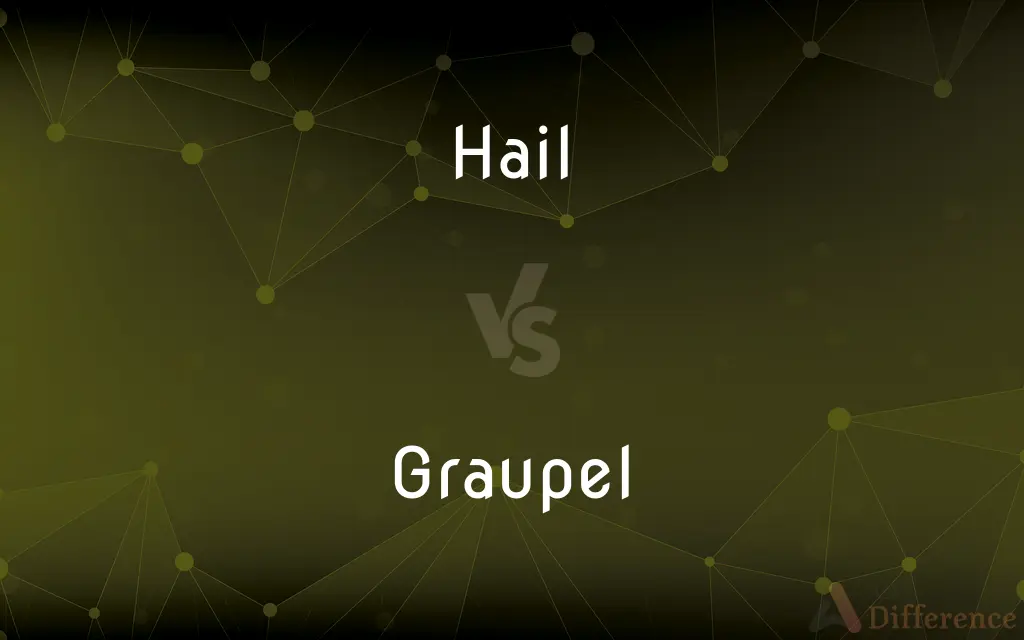Hail vs. Graupel — What's the Difference?
By Tayyaba Rehman & Fiza Rafique — Updated on April 7, 2024
Hail consists of solid ice spheres formed in thunderstorms, often causing damage. Graupel, also known as soft hail, is smaller, softer, and forms in colder clouds without thunder.

Difference Between Hail and Graupel
Table of Contents
ADVERTISEMENT
Key Differences
Hail is a form of solid precipitation that forms within the updrafts of thunderstorms, where water droplets freeze into ice balls or irregular lumps of ice before falling to the ground. On the other hand, graupel, often referred to as soft hail or snow pellets, consists of snowflakes that become coated with a layer of rime ice, resulting in a softer, less dense form of precipitation that typically falls in colder conditions without the need for thunderstorm activity.
While hailstones can grow to a significant size, becoming dangerous and capable of causing substantial damage to crops, vehicles, and structures, graupel tends to be smaller, with a typical diameter of 2-5 mm, and is much less likely to cause damage due to its softer composition and smaller size. This difference in size and potential for damage is a key distinction between the two types of precipitation.
The formation process of hail involves multiple ascents and descents within a thunderstorm, allowing the hailstone to accumulate layers of ice. Graupel, however, forms when supercooled water droplets freeze on a falling snowflake, creating a more uniform coating and a less layered structure. This process results in graupel having a more granular appearance compared to the often layered appearance of hailstones.
In terms of atmospheric conditions, hail is most commonly formed in strong thunderstorms with considerable vertical extents, indicating warmer weather conditions. Graupel forms in colder weather, within nimbostratus or cumulus clouds, and does not require the intense updrafts associated with thunderstorms, highlighting a fundamental difference in the weather patterns that produce each type of precipitation.
Both hail and graupel are indicators of active weather conditions, but their presence suggests different types of weather systems. Hail signals the presence of strong thunderstorms with severe weather potential, whereas graupel is more commonly associated with cold weather systems that can lead to snowfall, underlining the environmental and climatic variations between the two phenomena.
ADVERTISEMENT
Comparison Chart
Composition
Solid ice
Snowflakes coated with rime
Formation
In thunderstorms
In colder clouds
Size
Can be large, causing damage
Smaller, softer, less damaging
Structure
Often layered
Granular, less structured
Weather Conditions
Warm weather phenomena
Cold weather phenomena
Compare with Definitions
Hail
Can grow large and cause significant damage.
Golf ball-sized hail broke windows during the storm.
Graupel
Snowflakes coated with rime, resembling soft hail.
The graupel covered the ground with a soft, white layer.
Hail
Involves multiple ascents and descents within a storm.
The hailstone gained layers as it was tossed around in the storm.
Graupel
Forms in colder weather conditions.
The presence of graupel indicated a cold weather front.
Hail
Indicates strong thunderstorms.
The forecast warned of hail due to severe thunderstorms.
Graupel
Features a granular, less structured texture.
The graupel felt soft and granular when held.
Hail
Ice balls or lumps forming in thunderstorm updrafts.
The hail damaged the farmer's crops.
Graupel
Smaller and softer than hail.
The graupel was dense but caused no damage.
Hail
Forms in warmer weather conditions.
Hail formed as the summer thunderstorm intensified.
Graupel
Forms when supercooled droplets freeze on snowflakes.
As the snowflake fell, it collected droplets that froze into graupel.
Hail
Hail is a form of solid precipitation. It is distinct from ice pellets (American English "sleet"), though the two are often confused.
Graupel
Graupel (; German: [ˈɡʁaʊpl̩]), also called soft hail, corn snow, hominy snow, or snow pellets, is precipitation that forms when supercooled water droplets are collected and freeze on falling snowflakes, forming 2–5 mm (0.08–0.20 in) balls of crisp, opaque rime.Graupel is distinct from hail and ice pellets. Hail is common in thunderstorms, while graupel typically falls in winter storms and in convective showers especially at higher elevations.
Hail
Precipitation in the form of spherical or irregular pellets of ice larger than 5 millimeters (0.2 inch) in diameter, usually associated with thunderstorms.
Graupel
Precipitation consisting of snow pellets.
Hail
Something that falls with the force and quantity of a shower of ice and hard snow
A hail of pebbles.
A hail of criticism.
Graupel
A precipitation that forms when supercooled droplets of water condense on a snowflake.
Popcorn snow
Hail
The act of greeting or acclaiming.
Graupel
The result of this process, a small ball of rime.
Snow pellet
Hail
A shout made to catch someone's attention or to greet.
Hail
Hailing distance
Told me to stay within hail.
Hail
To precipitate in pellets of ice and hard snow.
Hail
To fall like hailstones
Condemnations hailed down on them.
Hail
To pour (something) down or forth
They hailed insults at me.
Hail
To salute or greet.
Hail
To greet or acclaim enthusiastically
The crowds hailed the boxing champion.
Hail
To call out or yell in order to catch the attention of
Hail a cabdriver.
Hail
To signal or call to a passing ship as a greeting or identification.
Hail
Used to express a greeting or tribute.
Hail
S or pieces of ice falling as precipitation, often in connection with a thunderstorm.
Hail
An occurrence of this type of precipitation; a hailstorm.
Hail
A rapid, intense barrage by a large number of projectiles or other objects.
Hail
(impersonal) Of hail, to fall from the sky.
They say it's going to hail tomorrow.
Hail
(intransitive) To send or release hail.
The cloud would hail down furiously within a few minutes.
Hail
To pour down in rapid succession.
Hail
(transitive) To greet; give salutation to; salute.
Hail
(transitive) To name; to designate; to call.
He was hailed as a hero.
Hail
(transitive) To call out loudly in order to gain the attention of.
Hail a taxi.
Hail
To indicate, from a designated stop or otherwise, to the driver of a public transport vehicle that one wishes to board and travel on the vehicle, usually using hand signals such as waving.
In Melbourne, you would usually have to hail a tram when you are travelling late at night and there are no other passengers waiting at your stop.
Hail
(transitive) To signal in order to initiate communication with.
Hail
(obsolete) Healthy, whole, safe.
Hail
An exclamation of respectful or reverent salutation, or, occasionally, of familiar greeting.
Hail
Small roundish masses of ice precipitated from the clouds, where they are formed by the congelation of vapor. The separate masses or grains are called hailstones.
Thunder mixed with hail,Hail mixed with fire, must rend the Egyptian sky.
Hail
A wish of health; a salutation; a loud call.
The angel hail bestowed.
Hail
To pour down particles of ice, or frozen vapors.
Hail
To pour forcibly down, as hail.
Hail
To call loudly to, or after; to accost; to salute; to address.
Hail
To name; to designate; to call.
And such a son as all men hailed me happy.
Hail
To declare, by hailing, the port from which a vessel sails or where she is registered; hence, to sail; to come; - used with from; as, the steamer hails from New York.
Hail
To report as one's home or the place from whence one comes; to come; - with from.
Hail
Healthy. See Hale (the preferable spelling).
Hail
An exclamation of respectful or reverent salutation, or, occasionally, of familiar greeting.
Hail
Precipitation of ice pellets when there are strong rising air currents
Hail
Enthusiastic greeting
Hail
Praise vociferously;
The critics hailed the young pianist as a new Rubinstein
Hail
Be a native of;
She hails from Kalamazoo
Hail
Call for;
Hail a cab
Hail
Greet enthusiastically or joyfully
Hail
Precipitate as small ice particles;
It hailed for an hour
Common Curiosities
How do hail and graupel differ in formation?
Hail forms through repeated cycling in thunderstorm updrafts, while graupel forms as supercooled water freezes on snowflakes.
What weather conditions are associated with hail?
Hail typically indicates strong thunderstorms, often occurring in warmer weather.
What is hail?
Hail is a type of solid precipitation consisting of ice balls or lumps that form in thunderstorms.
Is graupel a winter phenomenon?
Yes, graupel is more common in colder weather conditions and does not require thunderstorms.
Can graupel cause damage like hail?
Graupel is less likely to cause damage due to its smaller size and softer composition.
What is graupel?
Graupel, also known as soft hail, consists of snowflakes coated with rime, forming softer, less dense precipitation.
What is the significance of hail and graupel in weather forecasting?
Both indicate different weather systems; hail suggests severe thunderstorms, while graupel indicates cold weather fronts.
What safety measures should be taken for hail?
Protect vehicles, cover crops, and stay indoors to avoid injury from falling hailstones.
How can you distinguish hail from graupel?
Hail is usually harder and larger, while graupel is softer, smaller, and has a granular texture.
Why does hail cause more damage than graupel?
Hailstones can grow significantly larger and are much harder, making them capable of causing substantial damage.
Where is graupel most likely to form?
Graupel forms in colder clouds, often in nimbostratus or cumulus clouds, in cold weather systems.
Does hail indicate severe weather?
Yes, hail is often a marker of severe thunderstorms with strong updrafts.
Can hail and graupel occur simultaneously?
While rare, both can occur around the same weather system, especially in transitional weather conditions.
How do meteorologists predict hail?
They look for signs of strong thunderstorms with capable updrafts and sufficient moisture.
Is graupel considered snow?
While similar to snow, graupel is distinct due to its formation process and texture, often categorized separately.
Share Your Discovery

Previous Comparison
CMD vs. BAT
Next Comparison
Absence vs. PresenceAuthor Spotlight
Written by
Tayyaba RehmanTayyaba Rehman is a distinguished writer, currently serving as a primary contributor to askdifference.com. As a researcher in semantics and etymology, Tayyaba's passion for the complexity of languages and their distinctions has found a perfect home on the platform. Tayyaba delves into the intricacies of language, distinguishing between commonly confused words and phrases, thereby providing clarity for readers worldwide.
Co-written by
Fiza RafiqueFiza Rafique is a skilled content writer at AskDifference.com, where she meticulously refines and enhances written pieces. Drawing from her vast editorial expertise, Fiza ensures clarity, accuracy, and precision in every article. Passionate about language, she continually seeks to elevate the quality of content for readers worldwide.














































